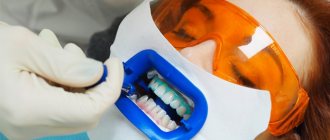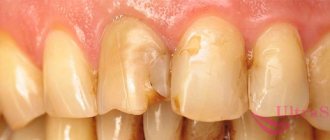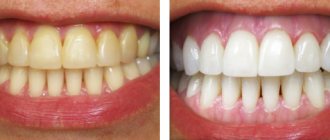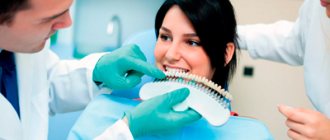Modern methods of obtaining a Hollywood smile make it possible to whiten teeth by 6 to 12 tones, and even remove old pigmented plaque. Procedures using ultrasound, laser, and the Zoom system are painless and safe, and the resulting effect lasts up to 5 years with proper oral care. However, when using even gentle techniques, the sensitivity of dental tissues increases, and the enamel loses part of its natural protection. After teeth whitening, it is very important to maintain your doctor's recommendations. They are aimed at reducing the risks of negative consequences and securing results.
What diet should you follow after whitening?
Before you whiten your teeth, you need to decide to change your diet for the next few weeks. In order for the resulting effect to be consolidated and preserved for a long time, they adhere to a white or transparent diet.
All foods that contain coloring pigments or that can cause darkening of the enamel are excluded from the diet:
- coffee, tea, red wine, juices, hot chocolate, cocoa, sweet sodas;
- beets, pumpkin, carrots, tomatoes, red cabbage;
- blueberries, blackberries, black currants, mulberries, blueberries, grapes, cranberries, pomegranates, raspberries, strawberries, cherries;
- black bread, buckwheat;
- spices with yellow pigment (turmeric, curry), paprika, cinnamon, nutmeg;
- confectionery products with artificial colors;
- liver, heart.
In general, the diet will remain rich, since there are many products and dishes included in the white diet. These include all light vegetables, meat, poultry, fish, milk and dairy products, potatoes, cereals, pasta, nuts, and oils. Among berries and fruits, white grapes, melon, pears, and bananas are neutral. Drinks you can drink are light juices, lightly brewed green tea, and mineral water.
Strengthen the enamel so it doesn't hurt!
During preparation for whitening, the dentist may recommend a course of remotherapy to strengthen the enamel and reduce its sensitivity.
The procedure is done in a clinic and continues independently at home for 14 days. Remotherapy can also be prescribed after teeth whitening.
We talk about remotherapy in the article What causes tooth sensitivity and will remotherapy help me?
Philips , which offers ZOOM whitening, for maximum safety and painlessness of the procedure, includes a special Relief gel in its whitening kits, which is applied to the teeth before and after the procedure.
Relief Gel strengthens enamel and reduces sensitivity during and after whitening.
See how Relief Gel protects your teeth.
Now that you are ready to whiten your teeth, let's figure out what whitening methods exist and what each of them is intended for.
Hygienic care rules
Since the gums and dental tissues become more sensitive and weakened during the first few weeks, special hygiene requirements must be observed:
- Replacing the brush. Bacteria accumulate on the bristles over time, so it is recommended to change the dental plaque removal tool once every three months. After the whitening procedure, this must be done immediately, as the gums and enamel may be slightly injured. Even small cracks will become a path for pathogens to penetrate inside. You need to buy a brush with soft bristles, and after a few weeks replace it with a harder one.
- Competent selection of toothpaste. Products are chosen with low abrasiveness. This indicator indicates the strength of plaque abrasion, or, more simply, hardness. In the specifications it is indicated by the abbreviation RDA. It should be within 30 - 50 units. To strengthen the surface layer and saturate the enamel with microelements, pastes with fluoride or calcium are chosen. The higher the percentage of these substances, the better. If gum sensitivity is increased, then buy restorative gels with herbal extracts.
- Mouth rinses. After eating, be sure to rinse your mouth with clean water or mouthwash. If there is inflammation of the gums, use safe antiseptic solutions: Chlorhexidine, Miramestin, Rotokan. Do not rinse with herbal decoctions, as they can stain.
- Comprehensive care. To maintain hygiene at a high level, additional devices are used: interdental brushes, flosses, irrigators. If teeth have been additionally cleaned to remove supragingival or subgingival calculus, anti-inflammatory and regenerating drugs are applied to the gums, for example, Metragil Denta.
In order to always have white and healthy teeth, you need to undergo professional oral hygiene at the dentist once every six months.
Preparing for teeth whitening
The better the condition of your teeth, the faster you can prepare for whitening and vice versa. There are relative and absolute contraindications. You can work with the first ones. In case of more serious problems, you will have to wait or refuse the procedure.
Bleaching should not be done in the following cases:
- Pregnancy and lactation;
- Age up to 14 years;
- Significant loss of enamel due to age-related changes or pathological abrasion;
- Availability of braces and other orthodontic structures.
- Teeth are loose
In addition, there is a whole list of things that you should eliminate before the procedures:
- Caries, pulpitis and periodontitis;
- Wedge-shaped defects, enamel microcracks, chips;
- Inflammatory processes on the gums and oral mucosa.
When eliminating defects, it should be remembered that the active composition that neutralizes the yellow pigment does not in any way affect the color of the fillings. This means that they will stand out strongly against the background of lightened enamel. Therefore, during treatment you need to put temporary fillings, then do bleaching and only after 14 days (when the color is fixed) install permanent ones.
In addition to eliminating various problems, the doctor may prescribe a course of remotherapy. This therapeutic and restorative technique allows you to strengthen weak enamel. A special gel restores mineral balance, eliminating microdefects and making teeth stronger. The procedure reduces tooth sensitivity and also minimizes the risk of developing caries. It can be done both before and after bleaching.
Brushing your teeth before whitening
Cleaning is a must, no matter what type of whitening you choose. The fact is that it allows you to determine the real color of your teeth. After this, the doctor will be able to more accurately say what the result of bleaching will be. In addition, when brushing, soft plaque and tartar are removed from the teeth, this is also important, since they would prevent the active gel from doing its job.
Today, there are several methods of professional cleaning. The two most popular are ultrasound and Air Flow. In some cases they are used in combination.
Cleaning with the Air Flow device is a simple and painless process. A special solution with small abrasive particles is applied to the teeth under pressure; it removes food debris from hard-to-reach places, as well as soft plaque from the surface of the teeth.
Another option is ultrasonic cleaning, we’ll tell you more about it. This procedure is carried out in three stages:
- Tartar removal. Hard deposits cannot be removed with a toothbrush or Air Flow; this requires the use of an ultrasonic scaler. It allows you to remove deposits that are located above and below the gum. Sometimes removing hard plaque can be painful, tell your doctor if you feel discomfort, he will remove the pain with an injection with an anesthetic.
- Soft cleaning with a nylon brush. Bacterial plaque prevents beneficial microelements from reaching the enamel, and in addition, contributes to the development and further accumulation of bacteria that provoke caries. To remove such plaque, the tooth surface is polished with a soft brush. The procedure is absolutely painless and resembles regular cleaning with an electric brush.
- Remineralizing therapy. After the teeth have been cleaned and polished, they are coated with fluoride gel, which is a very effective cavity preventative. Immediately after the procedure, spit out the remaining gel, but do not rinse your teeth with water. This ensures that the therapeutic effect will last for several more hours, which means that the benefits will be maximum.
Professional products from the ASEPTA series
Whitening, as we mentioned above, is not a joke procedure at all. With the wrong approach, there is a high risk of deteriorating dental health. The essence of professional whitening is very simple. A special gel is applied to the teeth; most often this preparation is made on the basis of hydrogen peroxide. After some time or under the influence of light, oxygen begins to be released from the gel, it penetrates the enamel, discoloring the yellow pigment. But in addition to the positive effect, demineralization occurs at the same time. This is why it is so important to strengthen your teeth before and after the procedure.
A good assistant in this matter will be high-quality oral care. The ASEPTA series includes special therapeutic and prophylactic pastes that strengthen enamel and prevent caries and gum inflammation. There are also special balms and gels for gum care. In addition, the use of rinses will be a good prevention of many oral diseases. They not only kill harmful bacteria, but also give your breath a pleasant aroma.
After whitening, to maintain the result, you can use ASEPTA PLUS GENTLE WHITENING paste or ASEPTA PLUS REMINERALIZATION paste.
What color of teeth can you get and how to maintain the whitening results for a long time?
In-office ZOOM whitening brightens teeth by 6-8 shades on the VITA scale. The result lasts for 1-2 years , subject to proper dental care and maintenance courses of home whitening.
In the first days after teeth whitening, it is important to follow a “white diet” - refrain from eating coloring foods.
In-office ZOOM whitening can be repeated no earlier than after 1 year.
We hope that we have helped you understand the variety of teeth whitening methods and the nuances that allow you to achieve a magnificent snow-white smile.
If you decide to have your teeth whitened, we will be happy to advise, conduct an examination and recommend the best whitening system for you.
We invite you to a consultation at NORD DENTAL clinics
What is better to forget: bad habits
Conducting a session forces a person to get rid of some addictions. Smoking does not benefit the body at all, and bleached teeth will turn black very quickly if you do not stop the addiction to cigarettes. The ingredients of tobacco smoke accumulate in the micropores of the enamel, which is exposed due to the procedure and becomes too vulnerable.
The habit of modern people to consume large quantities of caffeine also has a detrimental effect on the whiteness of treated teeth. It is recommended to direct your efforts to combat such “addiction”, because the aggressive pigments of caffeine-containing drinks instantly penetrate into the dental surface and neutralize the effect that was obtained through the brightening manipulation.
So, the amazing whitening results can be maintained for a long period. It is necessary to adhere to simple hygiene rules, follow a diet and overcome bad habits. A snow-white smile makes the face attractive, so your efforts will be completely justified!
When is it better to stop whitening?
The procedure for whitening tooth enamel is not always safe for the health of teeth and the entire body. There are a number of restrictions under which it is better to postpone the procedure or abandon it altogether.
Relative contraindications:
- inflammatory, infectious or viral diseases of the oral cavity;
- respiratory diseases;
- pregnancy and lactation period;
- treatment of bite with braces;
- taking potent medications.
Depending on the method of whitening, absolute contraindications may differ, but any procedure is not performed on children under 16 years of age, intoxicated, with mental disorders and the risk of allergies to the drug used.
How many shades can you lighten enamel: what doctors say
According to some patients, the best method of teeth whitening is the one that allows you to lighten your teeth by the maximum number of shades. Today, the maximum that can be achieved is 10-12 tones. It is possible to achieve such an impressive result if whitening is carried out using laser technologies, which, by the way, are also considered the most gentle in terms of their effect on hard tissues.
You can whiten your teeth several shades
Numerous studies show that supervised teeth whitening is the safest1 clinical procedure. At the same time, the result of the procedures is quite stable, and rarely returns to the original shade if, after bleaching, you follow all the doctors’ recommendations.
There are also many patients who prefer well-known photo-whitening methods (ZOOM, Amazing White, Luma-Arch, Beyond Polus), when a gel with hydrogen peroxide is first applied to the enamel, and then it is activated using various sources of heat and light: ultraviolet , halogen, LED lamps. This approach can lighten the enamel by 8-10 tones2.
There are also more “modest” professional methods, in which the whitening effect is lower, the negative impact on tissue is slightly higher, but the cost is also more interesting. For example, chemical whitening Opalescence, cosmetic whitening Magic White. All of them allow you to get an effect of 4-6 tones.
Many doctors express the opinion that the best teeth whitening is not at all what gives the maximum result and makes a snow-white smile. It is much better these days when the teeth are healthy, and also look well-groomed, clean, have a healthy shine and their natural shade. And today there are methods to help achieve all this. We are talking about professional cleaning, which allows for effective prevention of dental diseases and helps lighten the enamel by 1-2 tones.
Professional oral hygiene helps lighten the enamel by 1-2 tones
Soreness after a session: what does it mean?
Quite often people have toothache after whitening. What to do in such an unpleasant situation? Hypersensitivity is a natural phenomenon that can be disturbing on the first, or maximum on the second day after a whitening session. The reason for this is the active influence of dental instruments and drugs used to improve color.
Special products (rinses and pastes) will help to significantly reduce increased sensitivity and associated discomfort. If the pain is not severe, then it is advised to simply be patient and not eat very cold or hot foods.
If the pain intensifies and does not go away within 2-3 days, you should visit the dentist. Perhaps its cause was caries, gum inflammation or other serious pathologies of the oral cavity, aggravated by the manipulation.











